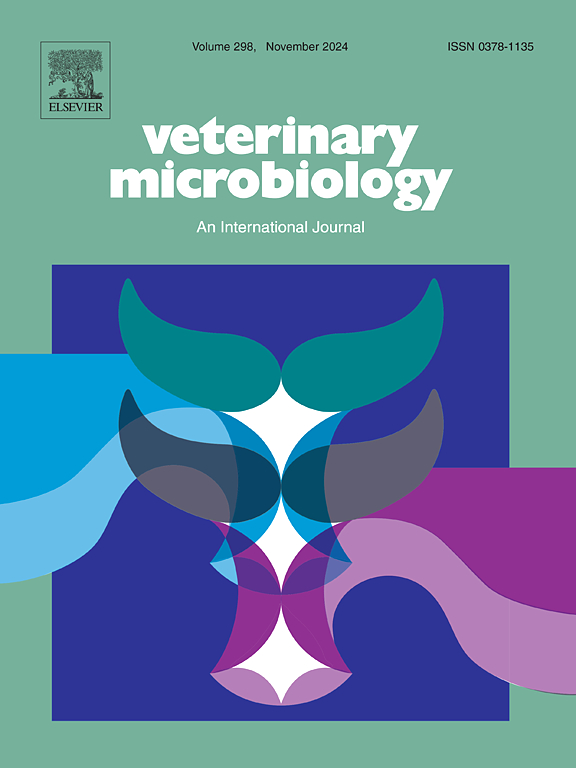芬兰两次肉鸡大肠杆菌病暴发中禽致病性大肠杆菌的基因组流行病学研究
IF 2.4
2区 农林科学
Q3 MICROBIOLOGY
引用次数: 0
摘要
在芬兰,2015年和2021年发生了明显的大肠杆菌病疫情,影响了全国各地的众多鸡群。肉鸡尸体的诊断检查显示经典的大肠杆菌病指标,如多浆膜炎、蜂窝织炎和股骨头坏死。禽致病性大肠杆菌(APEC)主要从病禽骨髓中分离,采用PCR方法进行分子分型。对2015年和2021年分别来自64个和91个禽群的375个和217个APEC分离株进行了分型。分型包括大肠杆菌系统发育组、o -血清组和8个毒力相关基因的测定。在2015年的疫情中发现了两种主要的APEC类型,在2021年的疫情中发现了一种。这些主要类型出现在大多数调查鸡群中(2015年64只鸡群中有47只(73 %),2021年91只鸡群中有75只(81 %))。随后对这些主要类型的APEC分离物进行全基因组测序(WGS)分析,发现它们在2015年为ST117 O78:H4和ST117 O53:H4,在2021年为ST23 O78:H4。分离物具有3个不同的克隆系,遗传差异小。此外,在其他北欧国家也同时发现了属于相同克隆谱系的APEC分离株。受影响的鸡群在流行病学上与共同的祖辈和祖辈鸡群有联系。这项研究强调,某些具有高毒力潜力的APEC菌株可以通过祖传畜群向后代的垂直传播,引发严重的大肠杆菌病暴发,影响几个国家的多个农场。PCR分型是一种经济可靠的方法,可快速检测导致大肠杆菌病暴发的APEC克隆谱系,随后的WGS分析提供了更详细的流行病学和遗传信息。这项研究的结果也可用于评估采样方法和确定APEC分离株之间的遗传差异,以诊断潜在的大肠杆菌病暴发。本文章由计算机程序翻译,如有差异,请以英文原文为准。
Genomic epidemiology of avian pathogenic Escherichia coli in two broiler colibacillosis outbreaks in Finland
In Finland, notable colibacillosis outbreaks occurred in 2015 and 2021, impacting numerous flocks across the country. Diagnostic examinations of broiler carcasses revealed classical colibacillosis indicators such as polyserositis, cellulitis, and femoral head necrosis. Avian pathogenic Escherichia coli (APEC) isolates were mainly collected from the bone marrow of diseased birds for molecular typing by PCR. Typing was conducted for 375 and 217 APEC isolates from 64 and 91 flocks from the years 2015 and 2021, respectively. Typing consisted of determination of the E. coli phylogeny group, O-serogroup, and eight virulence-associated genes. Two predominant APEC types were detected in the 2015 outbreak and one in the 2021 outbreak. These predominant types were present in the majority of investigated flocks (47 out of 64 flocks (73 %) in 2015 and 75 out of 91 flocks (81 %) in 2021). Subsequent whole-genome sequencing (WGS) analysis of a subset of APEC isolates of these predominant types revealed them to be ST117 O78:H4 and ST117 O53:H4 in 2015 and ST23 O78:H4 in 2021. The isolates represented three distinct clonal lineages with small genetic differences. In addition, APEC isolates belonging to the same clonal lineages were detected in other Nordic countries at the same time. The affected flocks were epidemiologically linked by common ancestral parent and grandparent flocks. This study underscores that certain APEC strains with a high virulence potential can trigger severe colibacillosis outbreaks affecting multiple farms in several countries by vertical transmission from ancestral flocks to offspring. PCR typing emerged as a cost-effective and reliable method for promptly detecting the APEC clonal lineages responsible for colibacillosis outbreaks, and subsequent WGS analysis provided more detailed epidemiological and genetic information. The results of this study could also be used in assessing sampling methods and determining genetic differences between APEC isolates in the diagnosis of potential colibacillosis outbreaks.
求助全文
通过发布文献求助,成功后即可免费获取论文全文。
去求助
来源期刊

Veterinary microbiology
农林科学-兽医学
CiteScore
5.90
自引率
6.10%
发文量
221
审稿时长
52 days
期刊介绍:
Veterinary Microbiology is concerned with microbial (bacterial, fungal, viral) diseases of domesticated vertebrate animals (livestock, companion animals, fur-bearing animals, game, poultry, fish) that supply food, other useful products or companionship. In addition, Microbial diseases of wild animals living in captivity, or as members of the feral fauna will also be considered if the infections are of interest because of their interrelation with humans (zoonoses) and/or domestic animals. Studies of antimicrobial resistance are also included, provided that the results represent a substantial advance in knowledge. Authors are strongly encouraged to read - prior to submission - the Editorials (''Scope or cope'' and ''Scope or cope II'') published previously in the journal. The Editors reserve the right to suggest submission to another journal for those papers which they feel would be more appropriate for consideration by that journal.
Original research papers of high quality and novelty on aspects of control, host response, molecular biology, pathogenesis, prevention, and treatment of microbial diseases of animals are published. Papers dealing primarily with immunology, epidemiology, molecular biology and antiviral or microbial agents will only be considered if they demonstrate a clear impact on a disease. Papers focusing solely on diagnostic techniques (such as another PCR protocol or ELISA) will not be published - focus should be on a microorganism and not on a particular technique. Papers only reporting microbial sequences, transcriptomics data, or proteomics data will not be considered unless the results represent a substantial advance in knowledge.
Drug trial papers will be considered if they have general application or significance. Papers on the identification of microorganisms will also be considered, but detailed taxonomic studies do not fall within the scope of the journal. Case reports will not be published, unless they have general application or contain novel aspects. Papers of geographically limited interest, which repeat what had been established elsewhere will not be considered. The readership of the journal is global.
 求助内容:
求助内容: 应助结果提醒方式:
应助结果提醒方式:


